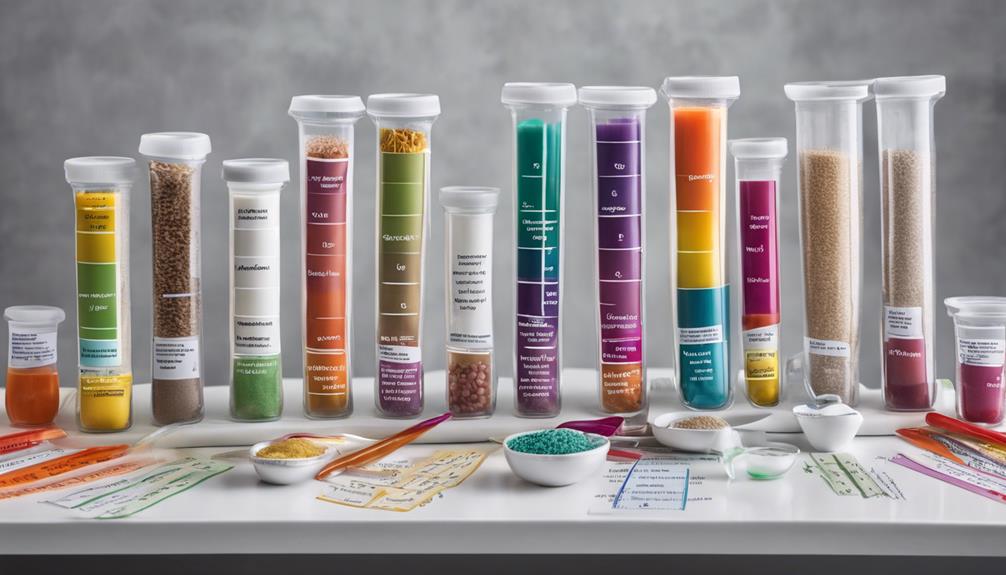In the quest to choose the ideal formula for feeding tube effectiveness, we have to sift through an abundance of choices to discover the best match. The distinct needs and situations of each patient demand thorough deliberation to ensure favorable results.
But how do we determine which formula will truly lead to success? Let's explore the key factors that influence this decision and uncover the secrets to achieving best nutrition and well-being for our patients.
Let's start on this journey together and reveal the path to feeding tube success.
Key Takeaways
- Consider patient factors like age, GI function, and dietary preferences for optimal formula selection.
- Evaluate nutritional needs and adjust formula based on caloric requirements and protein needs.
- Monitor for and address complications like aspiration pneumonia and electrolyte imbalances promptly.
- Regularly assess tolerance, nutrient intake, and patient outcomes to tailor feeding regimen for success.
Factors to Consider
When selecting the appropriate enteral nutrition formula, it's important to take into account various factors such as age, fluid status, GI function, food allergies, and diet preferences. Most patients can tolerate standard formulas, but specialty formulas require medical justification, potentially leading to cost implications. The decision-making process for formula selection should consider the institutional enteral formulary, the need for alternative options in specific cases, and insurance coverage.
Institutions often have a list of approved enteral formulas based on their patients' needs and clinical outcomes. It's essential to assess the patient's GI function to determine the most suitable formula that will be well-tolerated and provide the best nutrition. Understanding the individual's diet preferences can also guide the selection towards a formula that aligns with their tastes and lifestyle. Additionally, checking insurance coverage for the chosen formula is critical to guarantee affordability and long-term adherence to the enteral nutrition plan.
Nutritional Needs Assessment

Evaluating nutritional needs involves gauging caloric requirements, protein needs, and specific nutrient deficiencies to determine the most suitable enteral nutrition formula. When considering a patient's nutritional needs, several essential factors come into play:
- Patient Factors: Factors such as age, weight, medical history, and metabolic demands play an important role in determining the appropriate formula for enteral nutrition.
- GI Function and Allergies: Evaluating the patient's gastrointestinal function, fluid status, food allergies, and dietary preferences is crucial in selecting a formula that will be well-tolerated and effective.
- Formula Selection: Tailoring the choice between standard or specialty formulas based on specific nutritional goals is key to meeting the individual needs of the patient.
- Monitoring and Adjustment: Regularly monitoring the patient's response to the chosen formula and making adjustments based on tolerance and outcomes are essential for ensuring the success of enteral feeding.
Formula Selection Tips
To make an informed decision on selecting the appropriate enteral nutrition formula, it's important to take into account various factors such as patient age, fluid status, gastrointestinal function, allergies, and dietary preferences.
While most patients tolerate standard enteral formulas well, specialty formulas should only be considered with medical justification, as they may come with cost implications.
It's essential to gather information on enteral formulae from reliable sources like formula company websites, HCPCS codes, and institutional enteral formularies. Following ASPEN guidelines on enteral nutrition formulas, developed by experts like Lisa Epp, RD, LD, CNSC, can help in making the right choices.
Regularly reviewing and updating the enteral formula selection based on individual patient needs, medical history, and desired outcomes is key for optimum feeding tube success.
Avoiding Common Complications

Proper monitoring and adjustment of enteral nutrition formulas play a critical role in preventing common complications associated with tube feeding. When it comes to avoiding complications in tube feeding, here are some key points to take into account:
- Careful Monitoring: Regularly monitoring patients for signs of aspiration pneumonia, electrolyte imbalances, hyperglycemia, and diarrhea is essential to catch any issues early on.
- Proper Management: Ensuring proper management techniques are in place, such as adjusting formula types and rates based on patient tolerance and needs, can help prevent complications like tube clogging.
- Early Intervention: Promptly addressing any signs of intolerance or complications can significantly reduce the risk of more severe issues developing.
- Patient Tolerance: Tailoring the enteral nutrition formula to the patient's specific condition and nutritional requirements is crucial in maintaining patient tolerance and preventing adverse effects.
Monitoring Success and Adjusting
Regularly evaluating tolerance, nutrient intake, and patient outcomes is important in monitoring the success of enteral feeding. Adjusting the enteral formula may be necessary to optimize patient care. Factors such as GI function, caloric needs, and fluid status play a critical role in determining the effectiveness of the feeding regimen. Monitoring patient outcomes, including lab values, weight changes, and clinical signs, allows for timely adjustments to prevent complications and guarantee the patient's well-being.
Success in enteral feeding hinges on achieving and maintaining nutrition goals while minimizing adverse effects. Nutrient adjustments may be required to meet evolving patient needs and maintain the balance between caloric intake and fluid status. By staying vigilant and proactive in monitoring the patient's response to the enteral formula, healthcare providers can tailor the feeding regimen to promote the best outcomes.
Regular assessment and adjustment are key components in the successful management of enteral feeding, contributing to improved patient outcomes and overall health.
Frequently Asked Questions
How Do I Choose a Tube Feeding Formula?
When choosing a tube feeding formula, we consider factors like age, fluid status, GI function, food allergies, and diet preferences. Most patients can handle standard formulas, while specialty ones need medical justification and may cost more.
Formulas can be obtained from company websites, grouped by HCPCS codes, and checked for claims like gluten-free or organic. ASPEN guidelines don't endorse specific brands; it's best to consult healthcare pros for tailored advice based on assessments and desired outcomes.
Which of the Following Factors Are Considered When Selecting an Enteral Formula?
When selecting an enteral formula, we consider factors like age, fluid status, GI function, food allergies, and diet preferences. Most patients can handle standard formulas, but specialty ones need medical justification due to cost and insurance coverage.
Our institutional formulary guides us, though we always explore alternative options when necessary. We gather information from formula company websites and follow ASPEN guidelines for professional advice, steering clear of endorsing specific brands.
What Are the 4 Types of Enteral Formulas?
When it comes to enteral formulas, there are four main types: standard, disease-specific, semi-elemental, and elemental.
Standard formulas offer balanced nutrition for most patients, while disease-specific ones cater to specific medical conditions like diabetes or chronic kidney disease.
Semi-elemental formulas are partially hydrolyzed and good for gastrointestinal issues, and elemental formulas, fully hydrolyzed, aid patients intolerant to semi-elemental ones for easier digestion and absorption.
When Should I Change My Tube Feeding Formula?
When we need to change our tube feeding formula depends on various factors like medical condition shifts or nutrient requirements altering. If we encounter issues such as intolerance, diarrhea, or insufficient nutrient intake, it might be time for a change.
Seeking guidance from a healthcare provider or dietitian is important to make sure the timing and type of formula adjustment are appropriate for our needs. Regularly reassessing our response to the current formula helps determine if modifications are necessary.
Conclusion
Just as a gardener carefully selects the right fertilizer for their plants to thrive, choosing the right formula for feeding tube success is essential for the best patient health.
By considering factors such as nutrient requirements, allergies, and monitoring progress closely, we can guarantee that our patients receive the greatest possible care and support.
Like tending to a delicate flower, the right formula nourishes and sustains, leading to growth, strength, and vitality.










